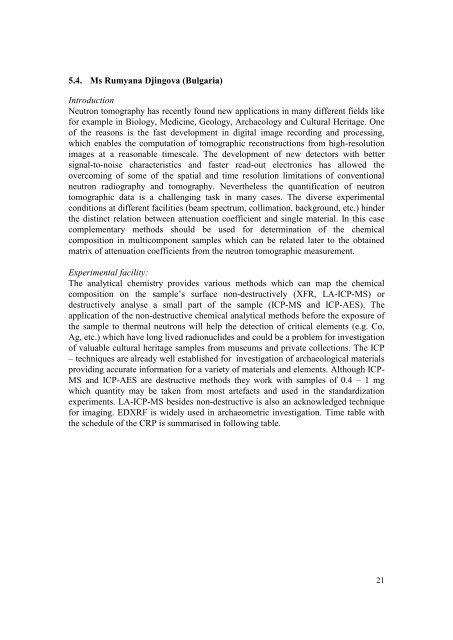Meeting report (pdf) - Nuclear Sciences and Applications - IAEA
Meeting report (pdf) - Nuclear Sciences and Applications - IAEA
Meeting report (pdf) - Nuclear Sciences and Applications - IAEA
You also want an ePaper? Increase the reach of your titles
YUMPU automatically turns print PDFs into web optimized ePapers that Google loves.
5.4. Ms Rumyana Djingova (Bulgaria)<br />
Introduction<br />
Neutron tomography has recently found new applications in many different fields like<br />
for example in Biology, Medicine, Geology, Archaeology <strong>and</strong> Cultural Heritage. One<br />
of the reasons is the fast development in digital image recording <strong>and</strong> processing,<br />
which enables the computation of tomographic reconstructions from high-resolution<br />
images at a reasonable timescale. The development of new detectors with better<br />
signal-to-noise characteristics <strong>and</strong> faster read-out electronics has allowed the<br />
overcoming of some of the spatial <strong>and</strong> time resolution limitations of conventional<br />
neutron radiography <strong>and</strong> tomography. Nevertheless the quantification of neutron<br />
tomographic data is a challenging task in many cases. The diverse experimental<br />
conditions at different facilities (beam spectrum, collimation, background, etc.) hinder<br />
the distinct relation between attenuation coefficient <strong>and</strong> single material. In this case<br />
complementary methods should be used for determination of the chemical<br />
composition in multicomponent samples which can be related later to the obtained<br />
matrix of attenuation coefficients from the neutron tomographic measurement.<br />
Experimental facility:<br />
The analytical chemistry provides various methods which can map the chemical<br />
composition on the sample’s surface non-destructively (XFR, LA-ICP-MS) or<br />
destructively analyse a small part of the sample (ICP-MS <strong>and</strong> ICP-AES). The<br />
application of the non-destructive chemical analytical methods before the exposure of<br />
the sample to thermal neutrons will help the detection of critical elements (e.g. Co,<br />
Ag, etc.) which have long lived radionuclides <strong>and</strong> could be a problem for investigation<br />
of valuable cultural heritage samples from museums <strong>and</strong> private collections. The ICP<br />
– techniques are already well established for investigation of archaeological materials<br />
providing accurate information for a variety of materials <strong>and</strong> elements. Although ICP-<br />
MS <strong>and</strong> ICP-AES are destructive methods they work with samples of 0.4 – 1 mg<br />
which quantity may be taken from most artefacts <strong>and</strong> used in the st<strong>and</strong>ardization<br />
experiments. LA-ICP-MS besides non-destructive is also an acknowledged technique<br />
for imaging. EDXRF is widely used in archaeometric investigation. Time table with<br />
the schedule of the CRP is summarised in following table.<br />
21
















